您现在的位置是:首页 >技术教程 >JS 实现区块链分布式网络网站首页技术教程
JS 实现区块链分布式网络
JS 实现区块链网络
这里主要 JS 实现区块链 实现的部分继续下去,对 Blockchain 这个对象有一些修改,如果使用 TS 的话可能要修改对应的 interface,但是如果是 JS 的话就无所谓了。
需要安装的依赖有:
-
express
-
body-parser
现在的 express 已经不内置 body-parser,需要作为单独的依赖下载
-
request
不下载会报错,是使用 request-promise 所需要的依赖
-
request-promise
可选的依赖包包括:
- concurrently
- nodemon
这两个主要为了方便热更新,详情参考:TypeScript 服务端热更新
⚠️:request 和 request-promise 已经 deprecated 了,具体 reference 可以参考 Request’s Past, Present and Future,以及 request 的代替品可以在这里查看:Alternative libraries to request
实现网络
单独的一个节点所要提供的功能有:
- 返回当前的 blockchain
- 添加新的交易
- 挖矿
package.json 的配置就不多提了,我是 yarn+concurrently+nodemon 的搭配。
基础设定如下:
-
index.ts
import express from 'express'; import bodyParser from 'body-parser'; const bitcoin = new Blockchain(); const app = express(); app.use(bodyParser.json()); app.use(bodyParser.urlencoded({ extended: false })); app.listen(3331, () => { console.log(`Listening on port 3331...`); });
这个时候服务器就起来了,是时候实现对应的 API 功能了。
get blockchain
第一个 API 的实现特别简单,只需要返回当前的 blockchain 即可:
app.get('/blockchain', (req, res) => {
res.send(bitcoin);
});
post transaction
这里是创建 transaction 的 API,基础的业务逻辑是从 request body 中获取交易的数额和交易双方的信息,随后创建一个新的 transaction,实现方法如下:
app.post('/transaction', (req, res) => {
const { amount, sender, recipient } = req.body;
const blockIdx: number = bitcoin.createNewTransaction(
amount,
sender,
recipient
);
res.json({ message: `transaction will be added in block ${blockIdx}` });
});
测试结果如下:
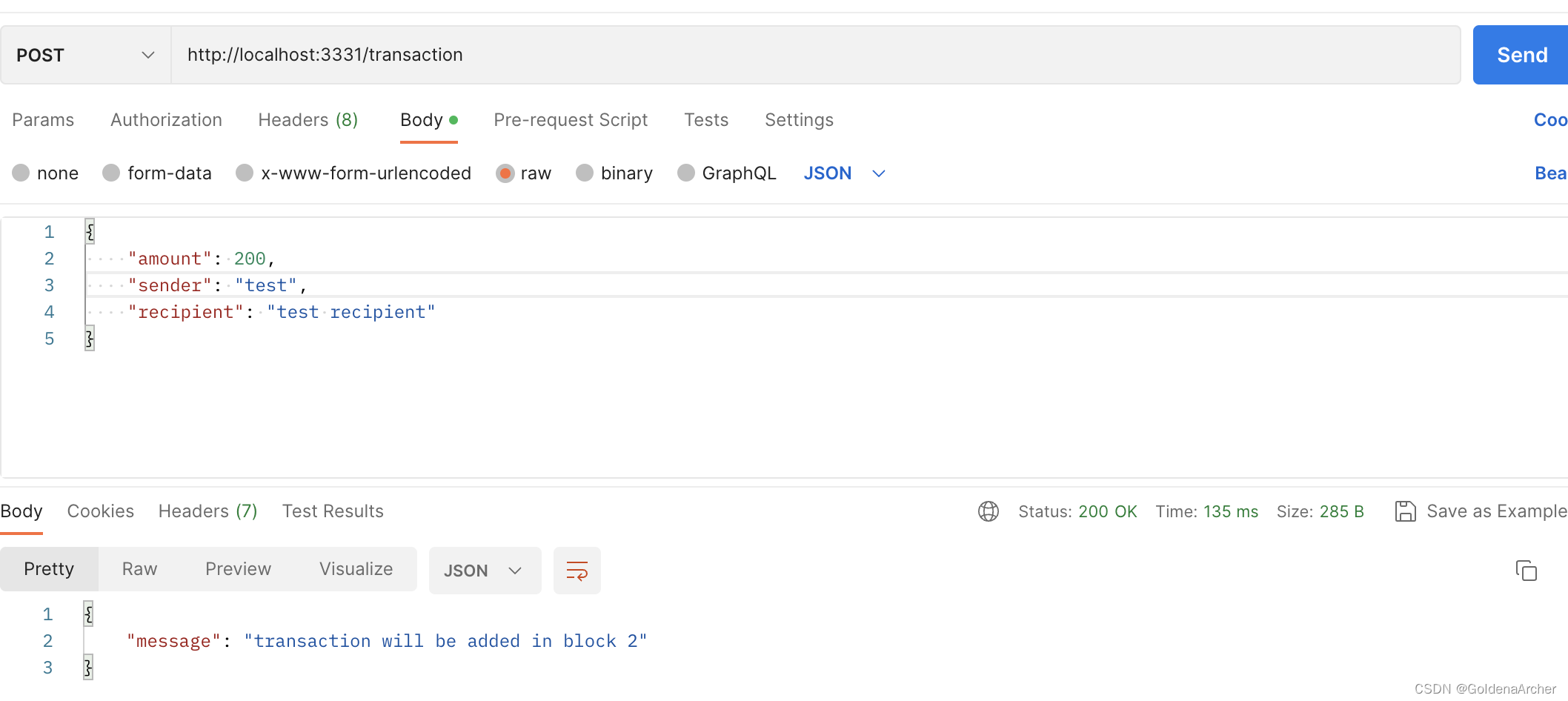
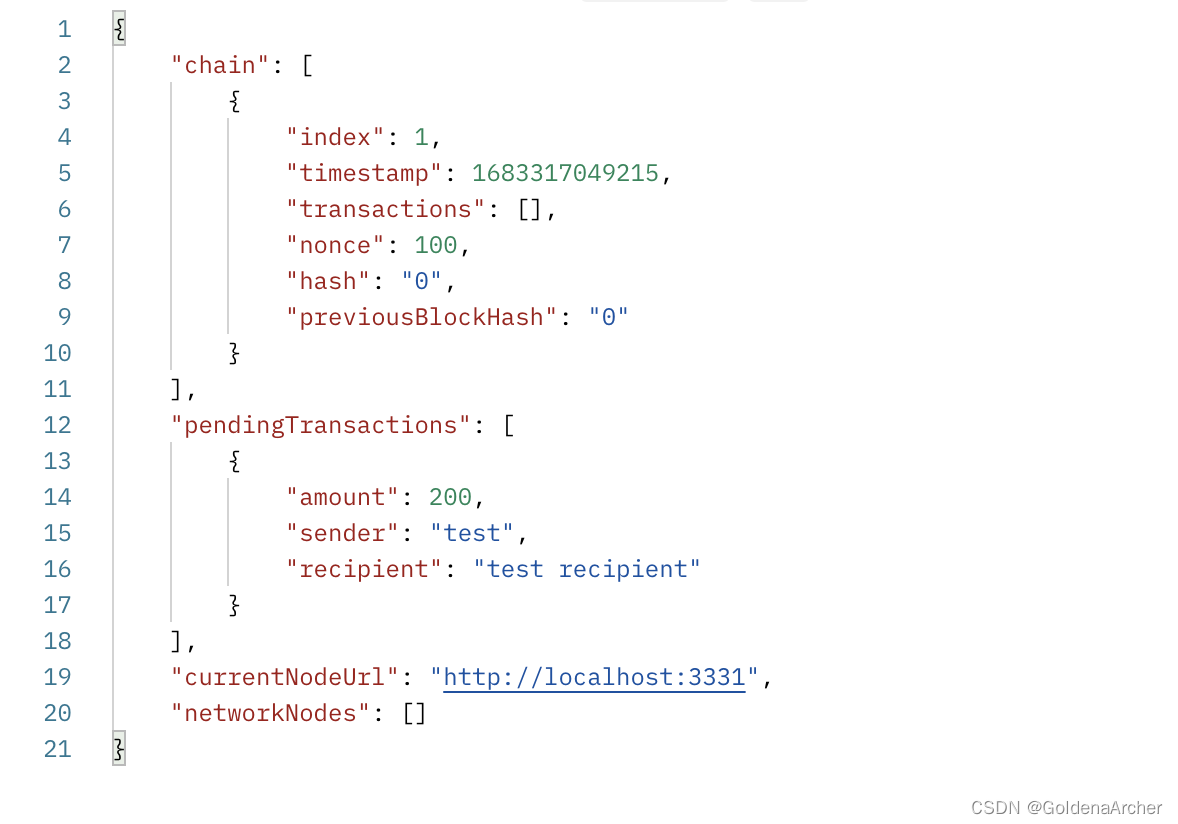
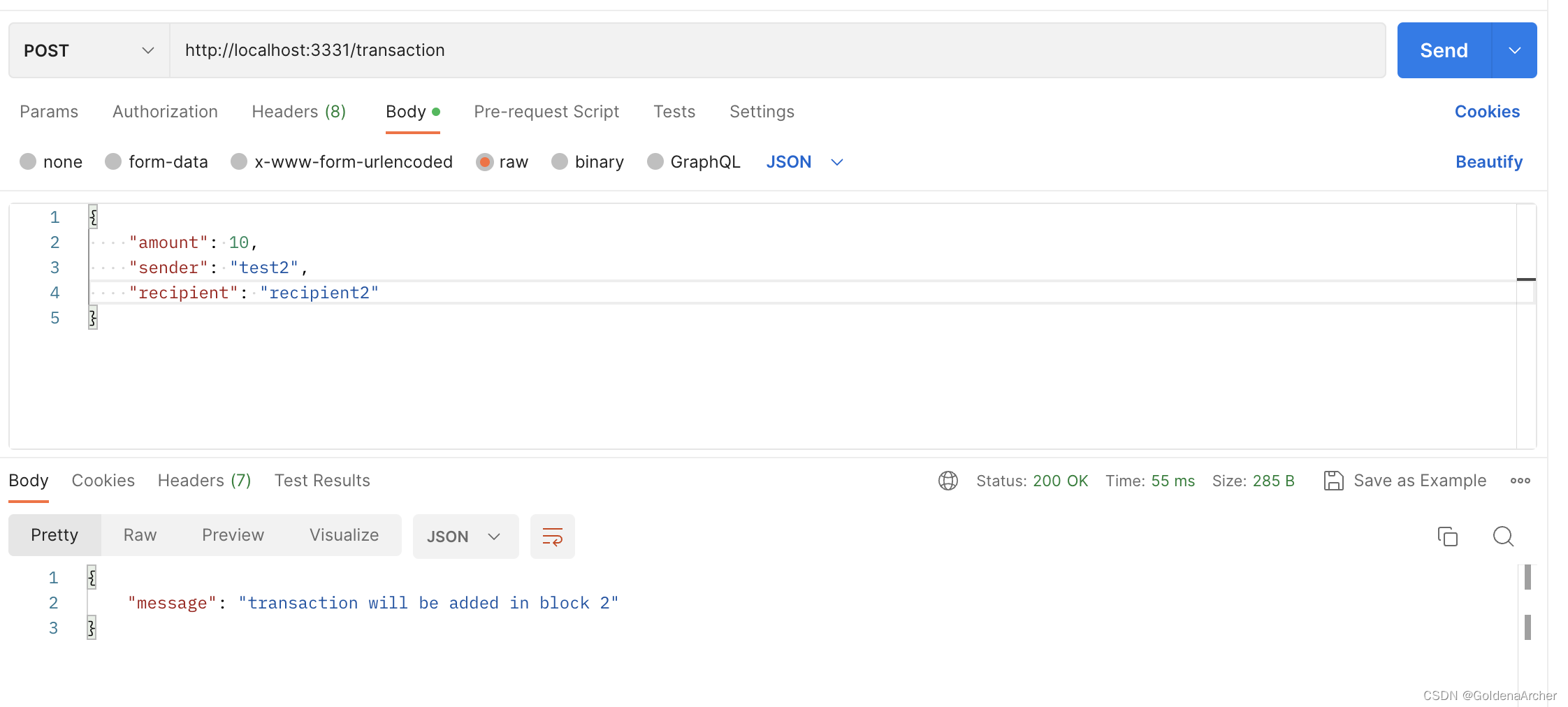

⚠️:重复一下,在当前 block 没有被 mine 之前,所有的 transaction 都会被推到当前 block 中。
get mine
这是整个单节点上业务逻辑最复杂的一部分,同样也需要修改一下 blockchain 的实现(如果用的是 ts)。
要成功的挖出当前的 block,基础的业务逻辑如下:
- 获取整个 blockchain 上最后一个 block
- mine 这个 block,一直获取到正确的 nonce
- 创建一个新的交易去奖励当前的矿工
- 创建一个新的 block
当然,这里所需的功能在 blockchain 对象中已经实现了。
接下来就根据上面的步骤实现挖矿的功能:
// 我没有用 uuid,而是直接使用内置的 crypto 去实现生成随机的 uuid 的功能
import crypto from 'crypto';
const nodeAddress = crypto.randomUUID().split('-').join('');
app.get('/mine', (req, res) => {
// 1. 获取当前 blockchain 上最后的 block
const lastBlock = bitcoin.getLastBlock();
// 2. 开始 mine,一直到获取正确的 nonce
// 2.1 在 mine 之前也需要获取对应的数据
const prevBlockHash = lastBlock.hash;
// 这里是更新的地方,之前的 blockData 的数据结构 为 Transaction | Transaction[],这里更新一下
const currBlockData = {
transactions: bitcoin.pendingTransactions,
index: lastBlock.index + 1,
};
const nonce = bitcoin.proofOfWork(prevBlockHash, currBlockData);
const blockHash = bitcoin.hashBlock(prevBlockHash, currBlockData, nonce);
// 3. 创建新的 transaction 去奖励当前的矿工
// 这里的收件方为当前 network 地址(随机生成)
bitcoin.createNewTransaction(12.5, '00', nodeAddress);
// 4. 创建新的 block
const newBlock = bitcoin.createNewBlock(nonce, prevBlockHash, blockHash);
res.json({ message: 'New block mined successfully', block: newBlock });
});
blockchain 修改的部分为:
interface BlockData {
index: number;
transactions: Transaction[];
}
// 修改 currBlockData 的数据类型就好,其他地方不用变
class Blockchain {
hashBlock = (
prevBlockHash: string,
currBlockData: BlockData,
nonce: number
) => {
// ...
};
proofOfWork = (prevBlockHash: string, currBlockData: BlockData) => {
// ...
};
}
这样就实现完了,沿用上面的结果,测试如下:
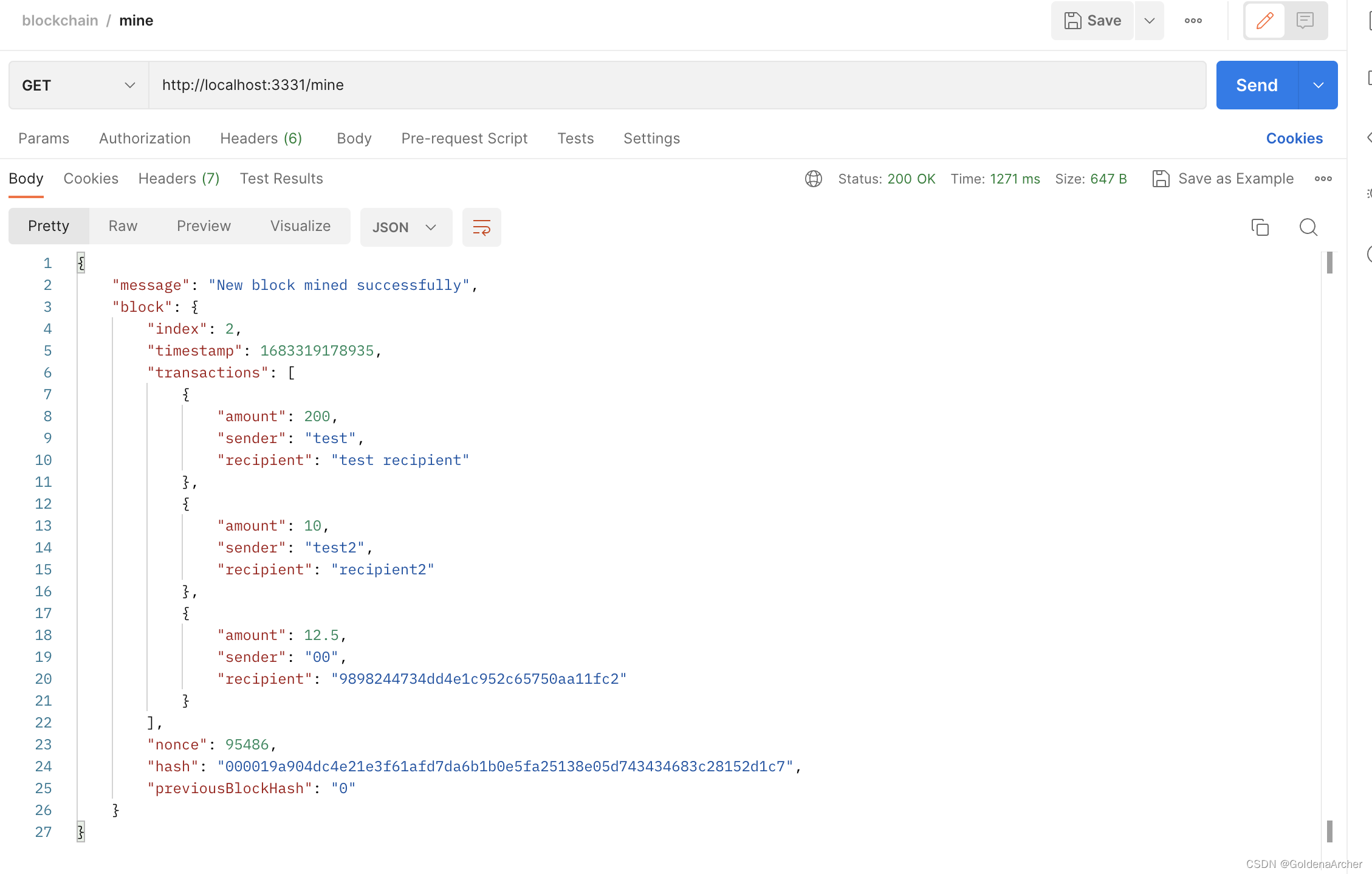
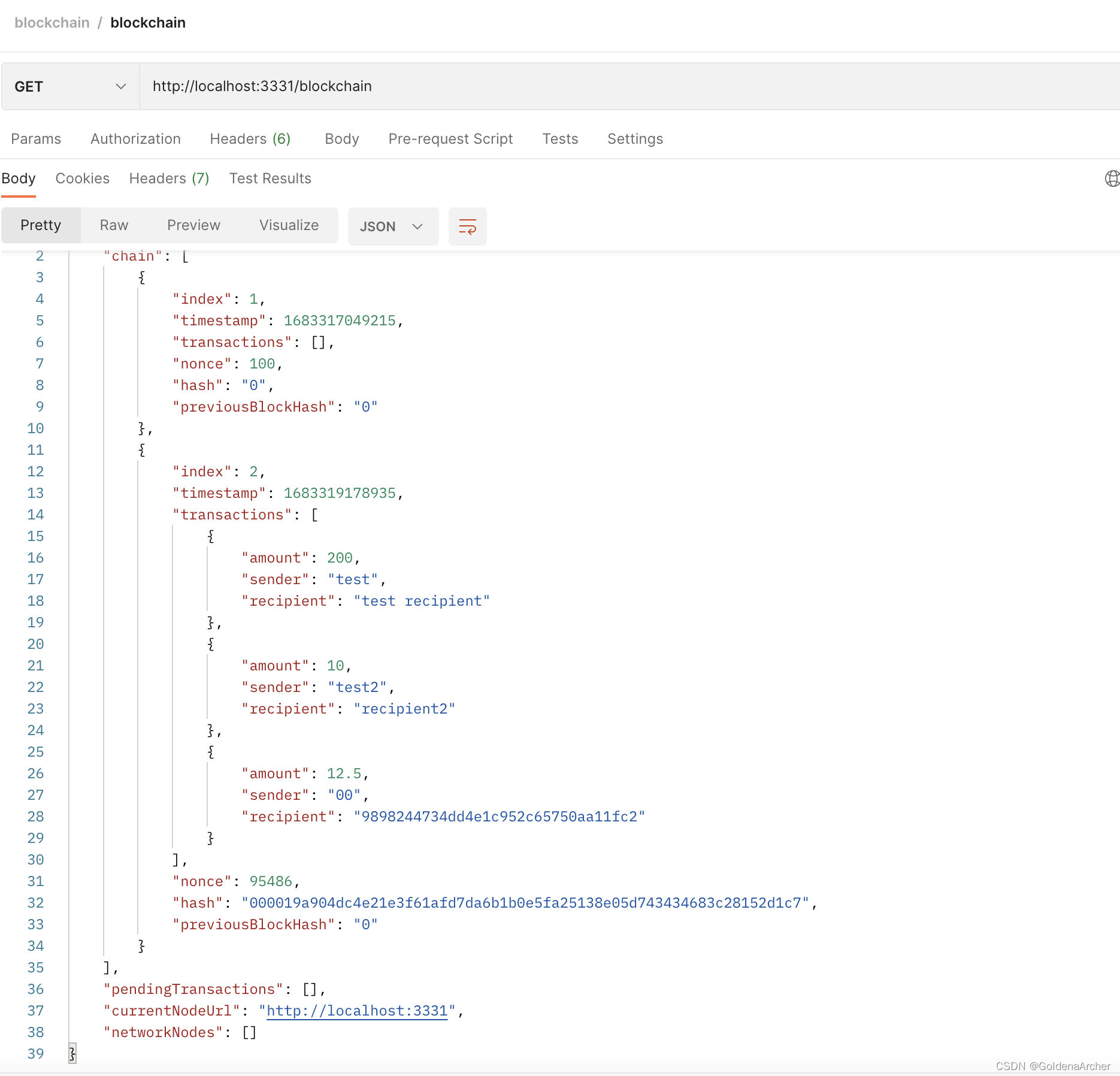
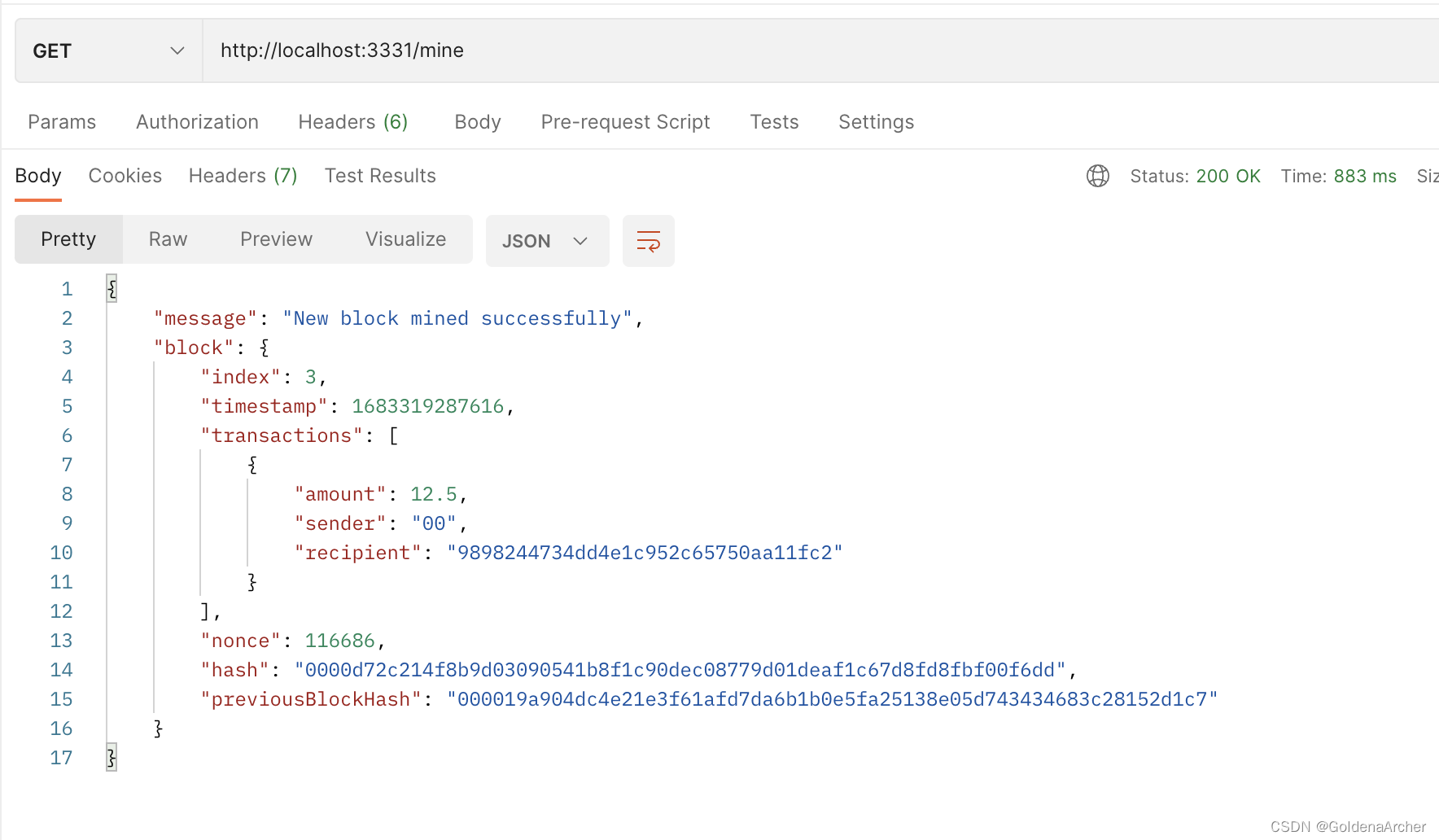
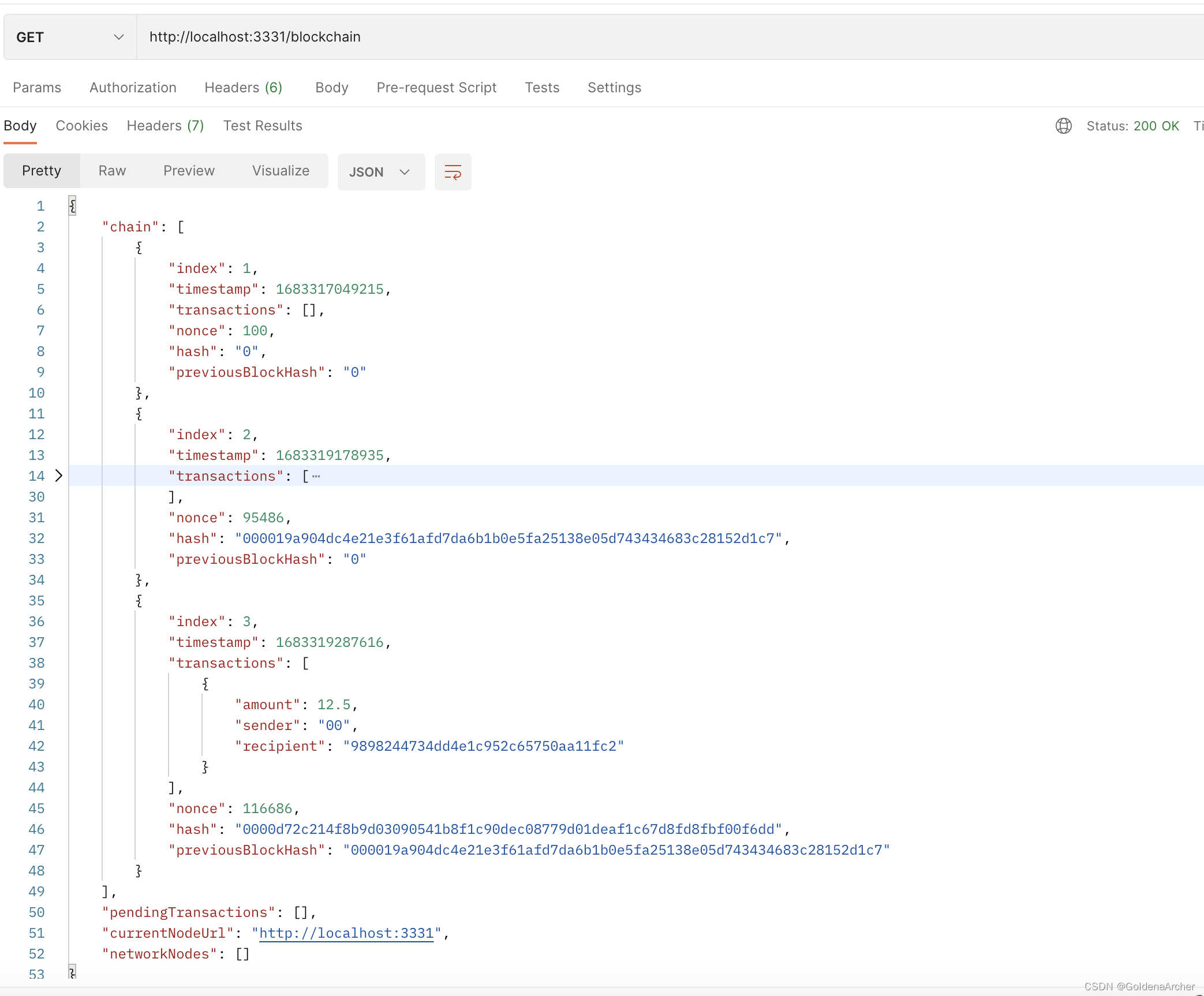
⚠️:每次 mine 都至少会创建 1 个 transaction,就是奖励当前挖矿人的奖励
实现去中心化区块链网络
区块链的一个特点就在于每一个结点都可以成为一个中心,所以每个结点都能够访问其他的结点:
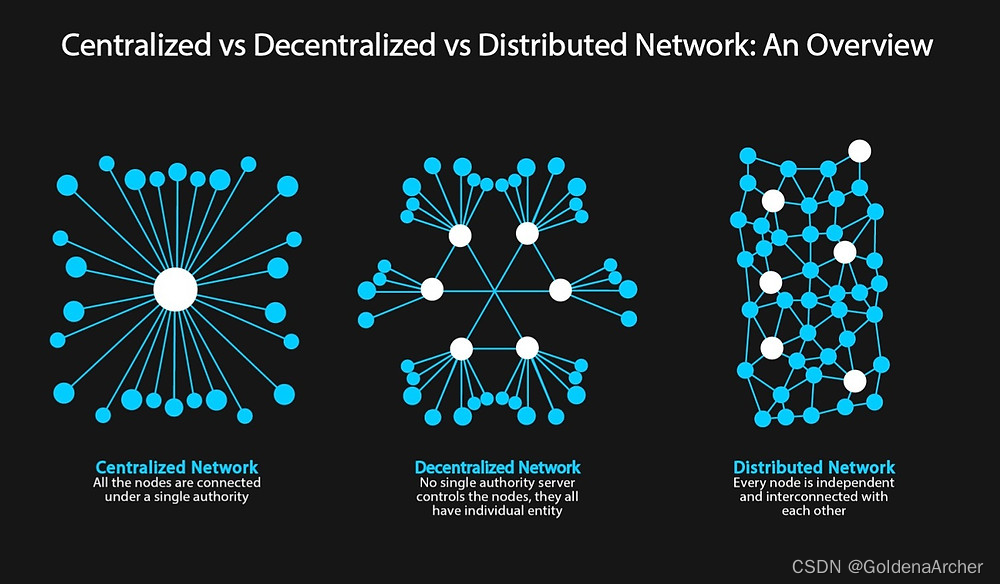
捋一下要做到这一点的流程:
-
每一个结点都需要群组去保存所有链接的结点
-
当一个新的结点 A 加入这个家庭的时候,它要通知其他的结点,将结点 A 加到其他结点已经存在的群组中
-
当其他的结点成功注册了结点 A,将 A 加到了自己的通讯录中
-
结点 A 也需要将其他的结点加到自己的通讯录中
接下来就根据这个逻辑去实现去中心化网络
修改配置和数据结构
首先修改 blockchain 对象,当前 blockchain 应该获取当前的网络,并能够存储相关联的网络,修改如下:
const currentNodeUrl = process.argv[3];
class Blockchain {
// ...
currentNodeUrl: string;
networkNodes: string[];
constructor() {
this.chain = [];
this.pendingTransactions = [];
// arbitrary values
this.createNewBlock(100, '0', '0');
this.currentNodeUrl = currentNodeUrl;
this.networkNodes = [];
}
}
这里将会使用 process.argv[3] 直接获取当前 node 的 url,因此,下一步就是修改配置文件,将 node url 作为命令行参数:
{
"scripts": {
"node_1": "concurrently "tsc -w" "nodemon dist/index.js 3331 http://localhost:3331"",
"node_2": "concurrently "tsc -w" "nodemon dist/index.js 3332 http://localhost:3332"",
"node_3": "concurrently "tsc -w" "nodemon dist/index.js 3333 http://localhost:3333"",
"node_4": "concurrently "tsc -w" "nodemon dist/index.js 3334 http://localhost:3334"",
"node_5": "concurrently "tsc -w" "nodemon dist/index.js 3335 http://localhost:3335""
}
}
again,这里用了 ts+nodemon+concurrently,所以这么修改的,如果不用一样的配置,可能需要自己想办法修改一下参数的问题。
运行结果如下:

这样当前网络上就有 5 个不相关联的结点正在运行了。
post register node
这一步其实是实现的步骤 3,也就是其他结点接受一个参数,并且将结点 A 加到自己的通讯录中。对于当前结点来说,它只需要知道 A 的地址,并且判断:
- 这个我是不是 A
- 我是不是已经加过 A 了
如果二者都不满足,那么当前结点就将 A 加入通讯录中。
app.post('/register-node', (req, res) => {
const newNodeUrl = req.body.newNodeUrl,
// 我没加过 A
nodeNotAlreadyPresent = !bitcoin.networkNodes.includes(newNodeUrl),
// 我不是 A
notCurrentNode = bitcoin.currentNodeUrl !== newNodeUrl;
if (nodeNotAlreadyPresent && notCurrentNode)
bitcoin.networkNodes.push(newNodeUrl);
// 这个也可以加到 if 里面,else 里面的信息表示没有已经存在或是自己
res.json({ message: 'New node registered successfully.' });
});
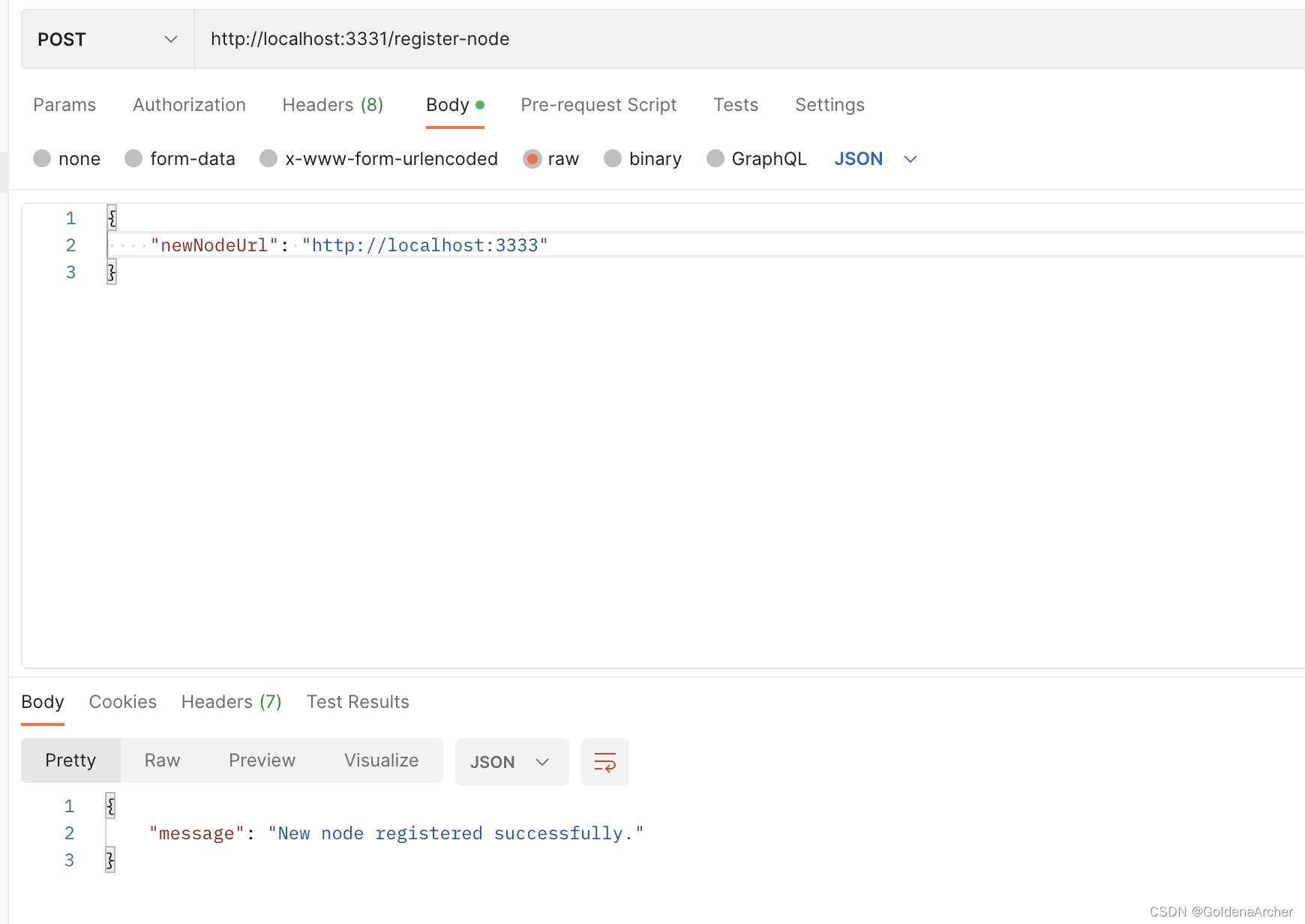
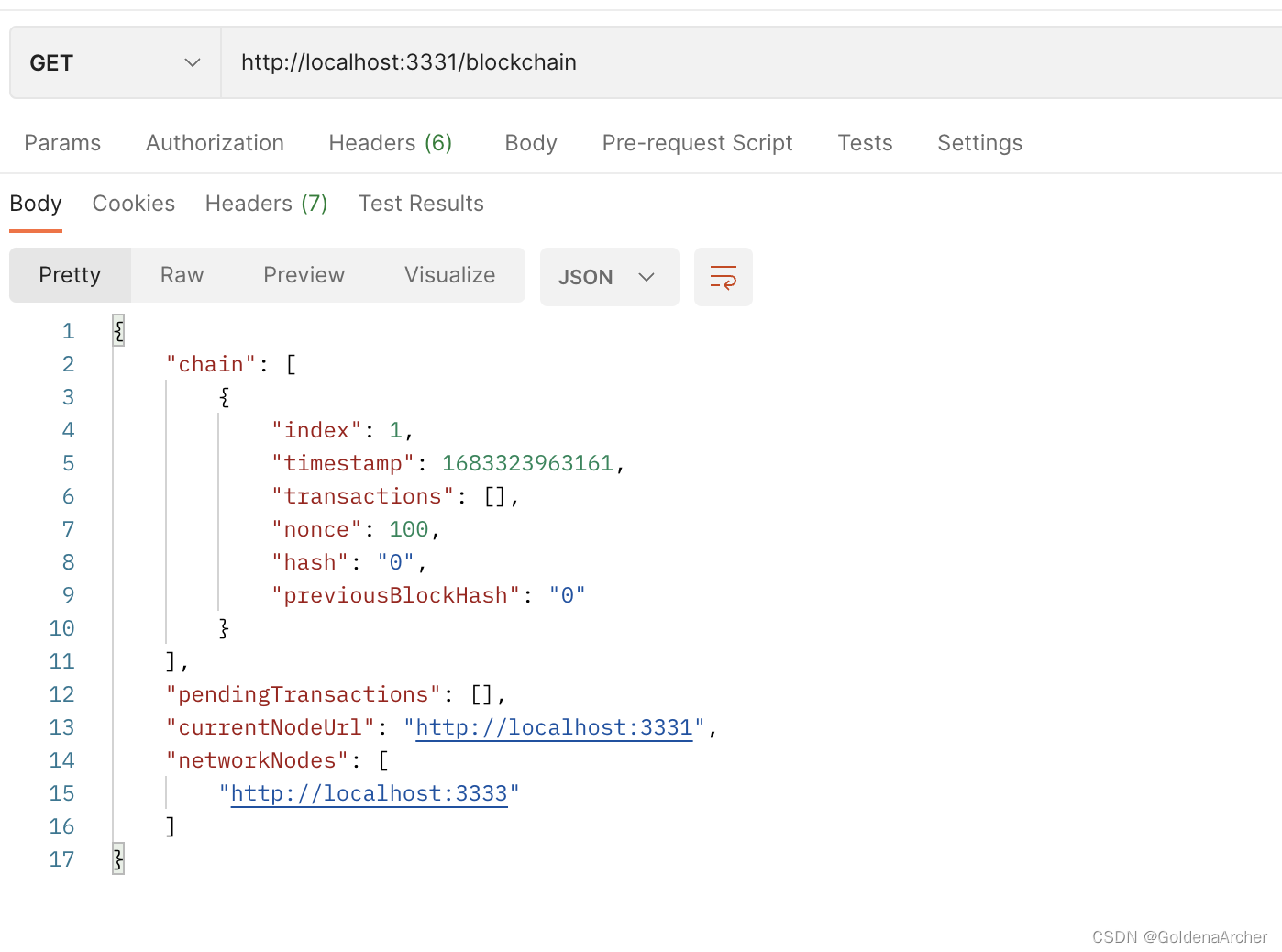
这里 3331 收到了 3333,所以 3331 会将 3333 加到自己的通讯录中,而 3333 暂时还没有将 3331 加到自己的通讯录中。
post register nodes bulk
这一步是滴 4 步,即其他的结点已经将 A 加到通讯录中了,A 也要将其他的结点加到通讯录中,所以这里接受的参数是一个数组。
实现如下:
app.post('/register-nodes-bulk', (req, res) => {
const allNetworkNodes: string[] = req.body.allNetworkNodes;
allNetworkNodes.forEach((networkNodeUrl) => {
const nodeNotAlreadyPresent =
!bitcoin.networkNodes.includes(networkNodeUrl),
notCurrentNode = bitcoin.currentNodeUrl !== networkNodeUrl;
if (nodeNotAlreadyPresent && notCurrentNode)
bitcoin.networkNodes.push(networkNodeUrl);
});
res.json({ message: 'Bult registration successful.' });
});
测试如下:
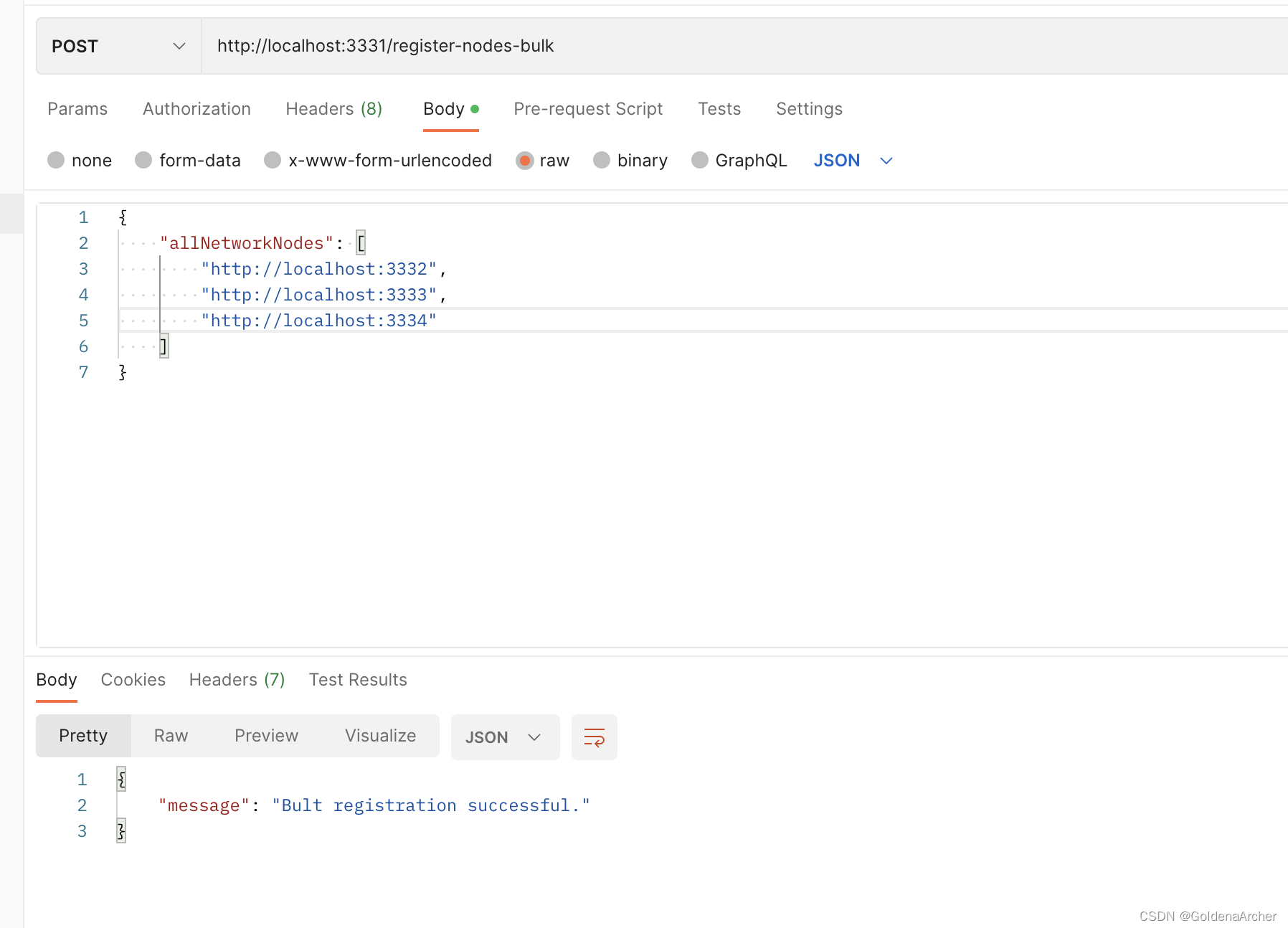

这两个细节都完成了,现在可以跳回去补全第 2 步了。
post register & broadcast
实现如下:
app.post('/register-and-broadcast-node', (req, res) => {
const newNodeUrl = req.body.newNodeUrl;
if (!bitcoin.networkNodes.includes(newNodeUrl))
bitcoin.networkNodes.push(newNodeUrl);
const regNodesPromises: RequestPromise<any>[] = [];
bitcoin.networkNodes.forEach((networkNodeUrl) => {
// register node
const requestOptions = {
uri: networkNodeUrl + '/register-node',
method: 'POST',
body: { newNodeUrl },
json: true,
};
regNodesPromises.push(rp(requestOptions));
});
Promise.all(regNodesPromises)
.then((data) => {
const bulkRegisterOptions = {
uri: newNodeUrl + '/register-nodes-bulk',
method: 'POST',
body: {
allNetworkNodes: [...bitcoin.networkNodes, bitcoin.currentNodeUrl],
},
json: true,
};
return rp(bulkRegisterOptions);
})
.then((data) => {
res.json({ message: 'New node registered with network successfully.' });
});
});
测试结果如下:
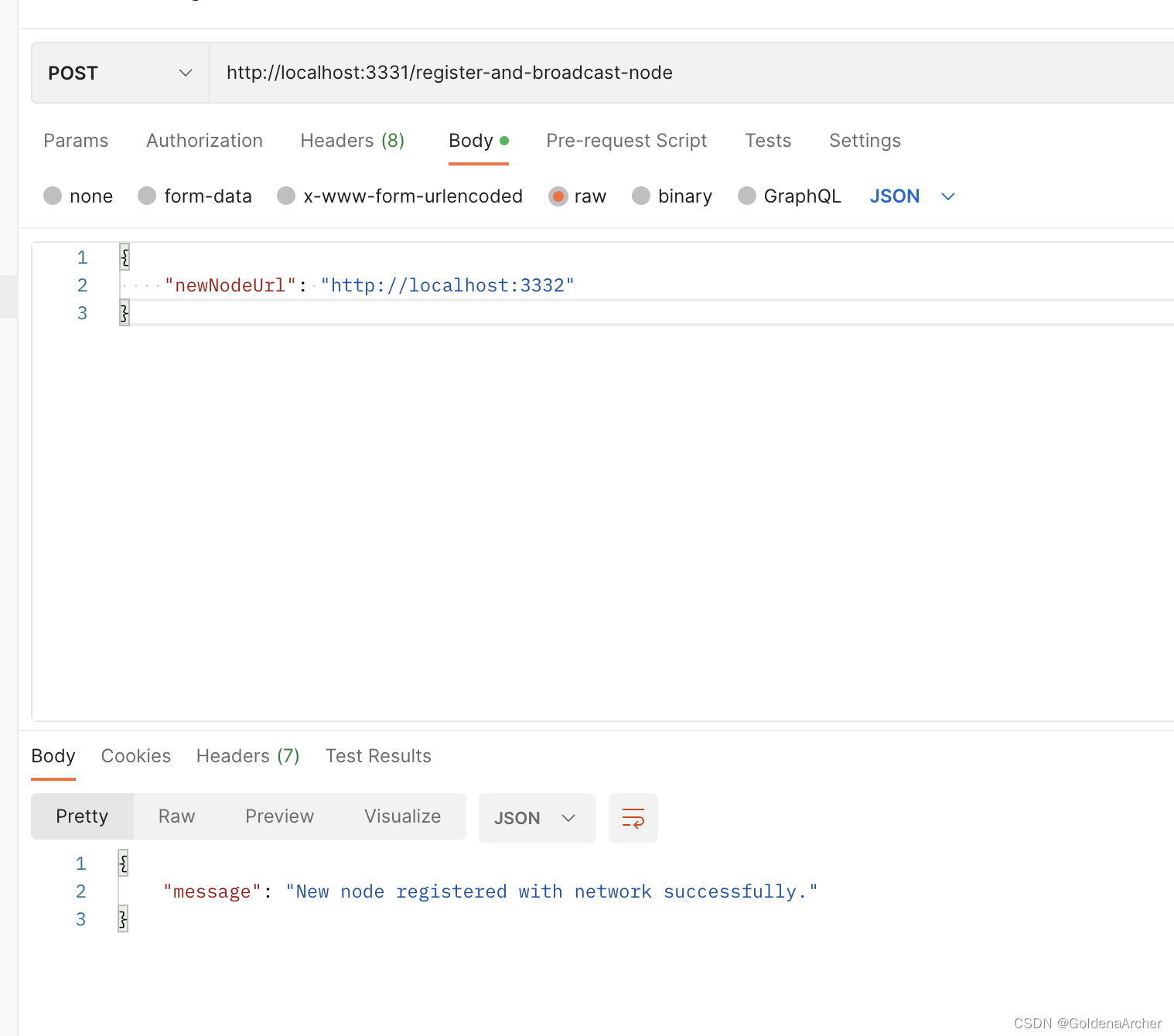
这里 3331 和 3332 作为两个单独的结点被连接在了一起了,从逻辑上可以理解声 3332 加入到了 3331 的群组中。
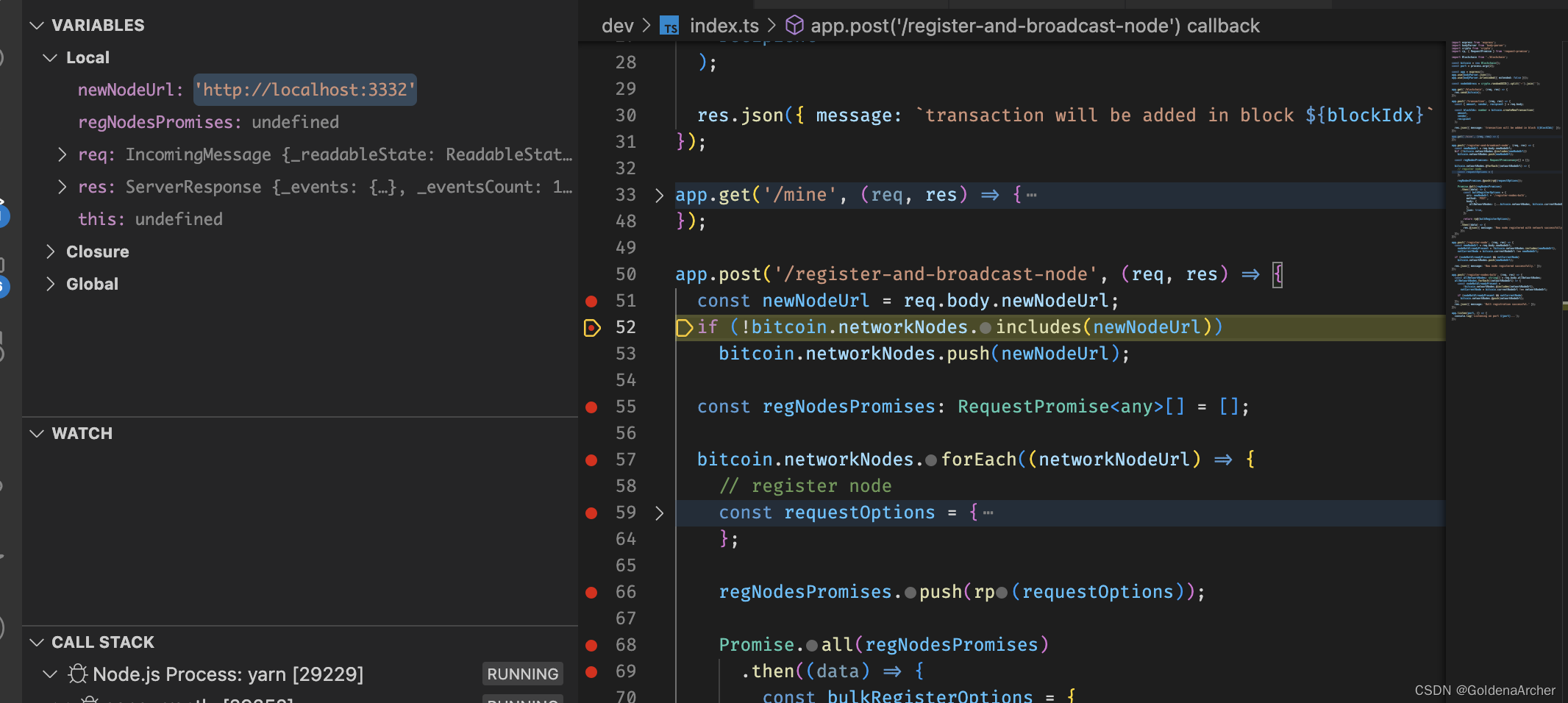
3331 所在群组通过判断,发现 3332 不在自己的群组中,所以它们决定把 3332 加到各自成员中的通讯录中(即所有群组成员都调用一次 /register-node)。
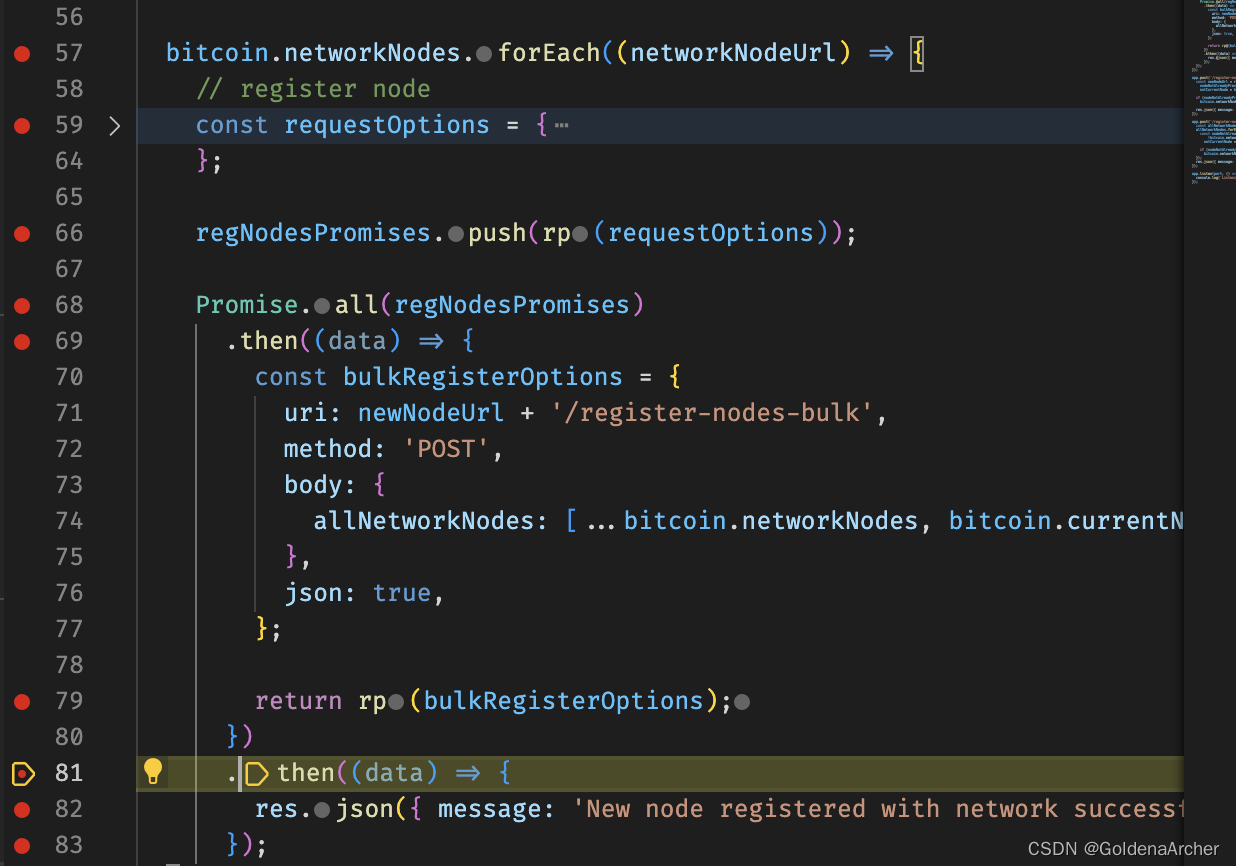
成功哦那个 3332 将组群内的成员加到自己的通讯录中,最后返回调用成功。
这个时候再尝试让 3333 加入 3332(即 3332 和 3331)所在的群组中:
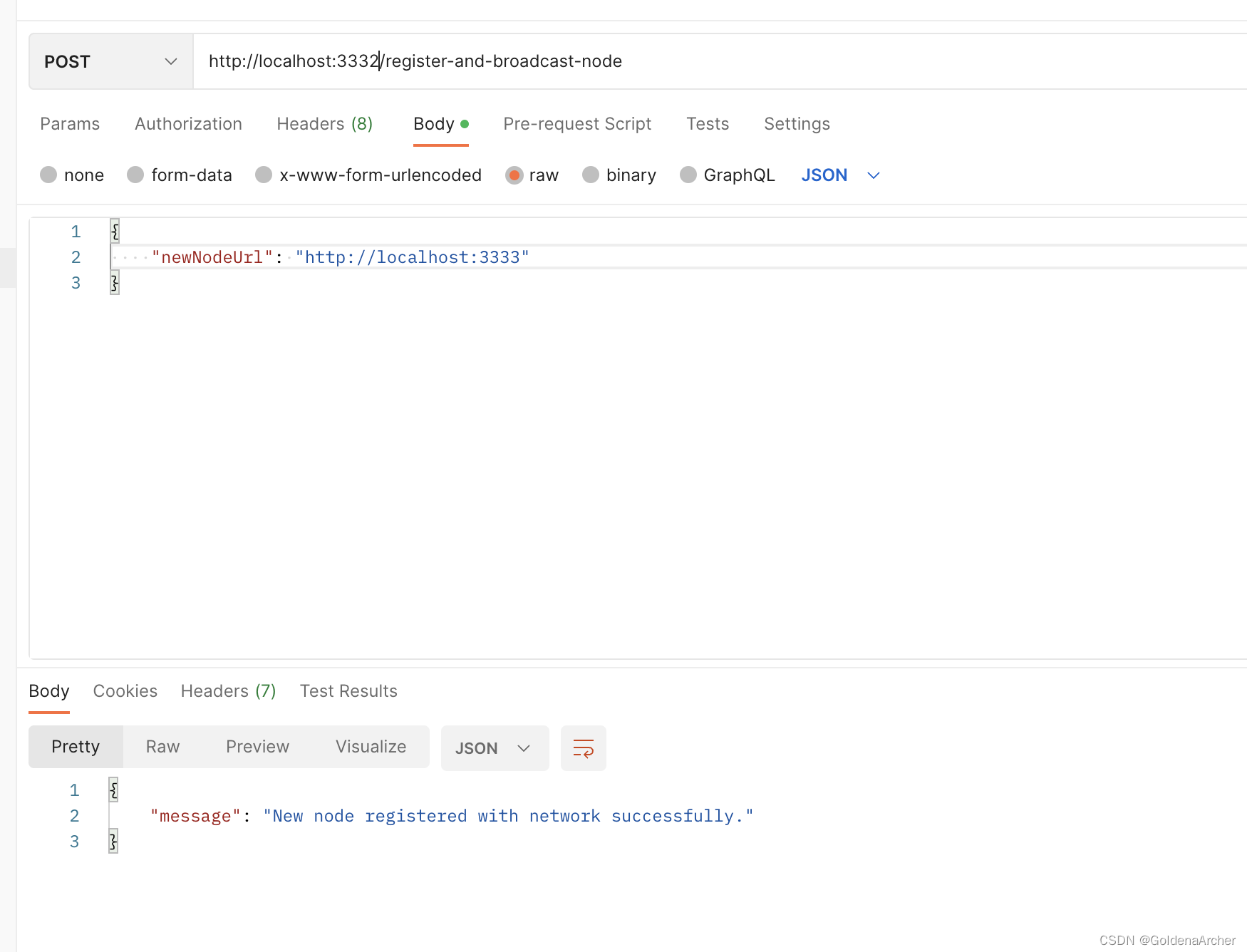
同样的步骤:
3333 先尝试加入这个家庭:
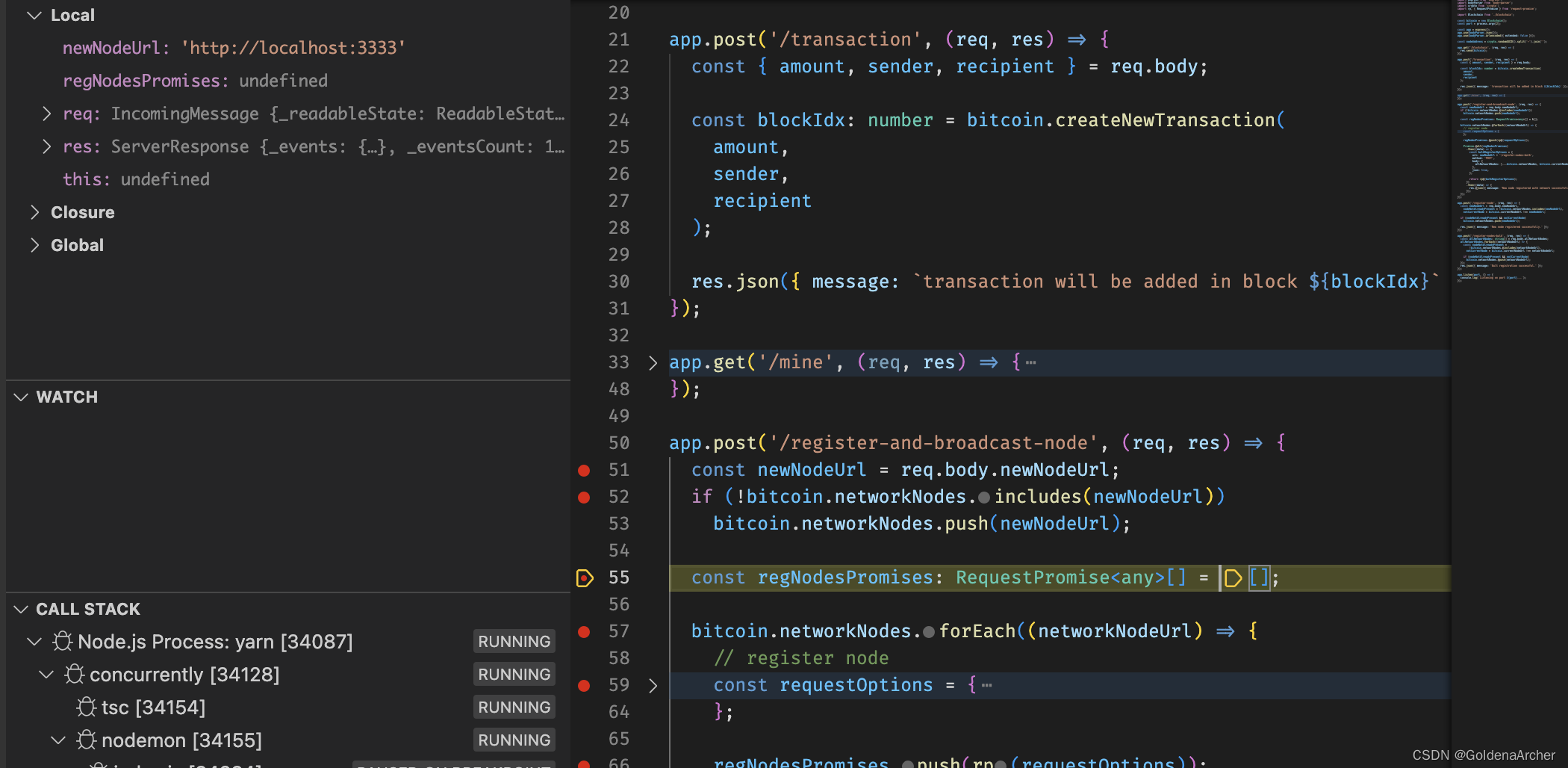
3331 和 3332 接收了新成员:

成功后 3333 将 3331 和 3332 加入到自己的通讯录中,完成加入。
现在的问题就是,每一个结点有着单独一个 blockchain 的 instance,而在现实生活中,所有的网络节点都在同一个区块链上工作。
下一步就会尝试解决这个问题。






 U8W/U8W-Mini使用与常见问题解决
U8W/U8W-Mini使用与常见问题解决 stm32使用HAL库配置串口中断收发数据(保姆级教程)
stm32使用HAL库配置串口中断收发数据(保姆级教程) 分享几个国内免费的ChatGPT镜像网址(亲测有效)
分享几个国内免费的ChatGPT镜像网址(亲测有效) QT多线程的5种用法,通过使用线程解决UI主界面的耗时操作代码,防止界面卡死。...
QT多线程的5种用法,通过使用线程解决UI主界面的耗时操作代码,防止界面卡死。... SpringSecurity实现前后端分离认证授权
SpringSecurity实现前后端分离认证授权